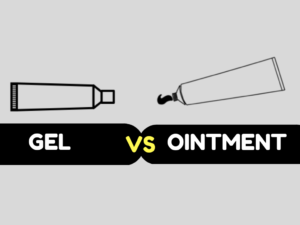Difference between Ointment and Paste
What is Ointment?
An ointment is a type of semisolid preparation that is used externally on the skin. It is a mixture of oils and waxes that can be easily spread and applied to the affected area. Ointments are typically used for dermatological conditions, such as skin irritations, rashes, and burns.
Examples of Ointment
Some common examples of ointments include:
- Neosporin
- Preparation H
- Bacitracin
- Vaseline
What is Paste?
Paste, on the other hand, is a type of semisolid preparation that is thicker and more viscous than ointment. It is also used externally on the skin, but it tends to be formulated with a higher concentration of solids. Pastes are commonly used for conditions that require a drying or protective effect, such as diaper rash or psoriasis.
Examples of Paste
Some common examples of paste include:
- Zinc oxide paste
- Sodium bicarbonate paste
- Mentholated paste
- Clotrimazole paste
Differences between Ointment and Paste
| Difference Area | Ointment | Paste |
|---|---|---|
| Semisolid consistency | Soft and easily spreadable | Thicker and more viscous |
| Concentration of solids | Lower concentration | Higher concentration |
| Function | Moisturize, soothe, and protect the skin | Dry and protect the skin; provide a barrier |
| Application | Easy to spread on the affected area | Thicker consistency, needs more effort to spread |
| Uses | Treat skin irritations, rashes, burns | Treat diaper rash, psoriasis, bedsores |
| Absorption | Less absorbent | More absorbent |
| Longevity | Lasts longer on the skin | May require more frequent application |
| Consistency | Smooth and greasy | Thicker and stickier |
| Ingredients | Oil and wax-based | Higher content of solid ingredients |
| Use on open wounds | Not recommended for open wounds | Suitable for open wounds to protect and promote healing |
Conclusion:
In summary, the main difference between ointment and paste lies in their consistency, concentration of solids, function, application, and uses. Ointments have a softer and easily spreadable consistency, with a lower concentration of solids, and are used to moisturize, soothe, and protect the skin. On the other hand, pastes are thicker, have a higher concentration of solids, and are used to dry and protect the skin, often serving as a barrier. Ointments are commonly used to treat skin irritations, rashes, and burns, while pastes are used for conditions like diaper rash, psoriasis, and bedsores.
People Also Ask:
Q: Can I use ointment and paste interchangeably?
A: Ointments and pastes have different consistencies and concentrations of active ingredients, so they are not interchangeable. It is important to use the appropriate product for your specific condition.
Q: Are ointments or pastes more effective?
A: The effectiveness of ointments and pastes depends on the specific condition being treated. Ointments are typically used for conditions that require moisturizing and soothing effects, while pastes are used for drying and protective effects.
Q: How often should I apply ointments and pastes?
A: The frequency of application will depend on the specific product and the instructions provided by your healthcare professional. It is important to follow the recommended dosage and application guidelines.
Q: Can ointments and pastes be used on children?
A: Yes, both ointments and pastes can be used on children, but it is important to follow the recommended age guidelines and consult with a healthcare professional if you have any concerns.
Q: Can ointments and pastes be used on open wounds?
A: Ointments are generally not recommended for use on open wounds, as they can trap bacteria and hinder the healing process. Pastes, on the other hand, are often used to protect and promote healing in open wounds.


